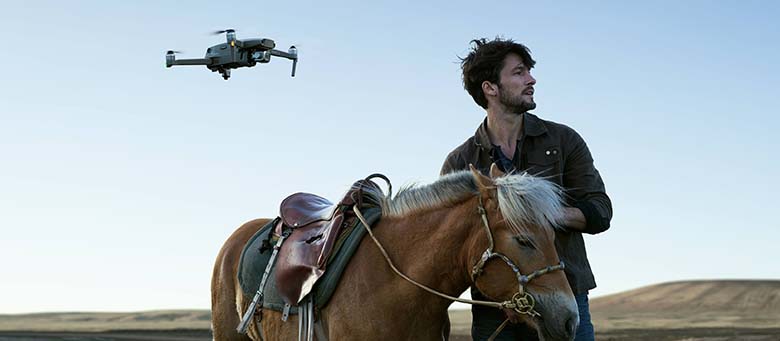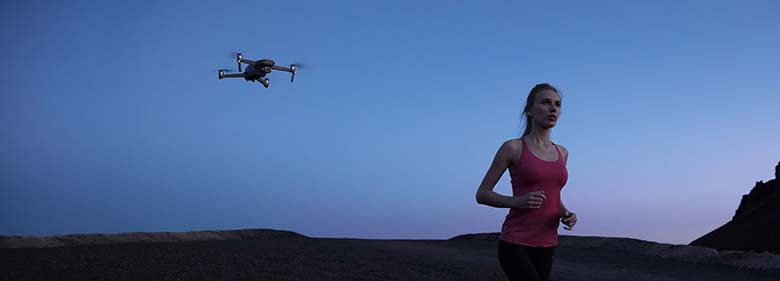The DJI Drone manufacturing brand is a well-known brand, which is offering high performing drones and quadcopters. It has launched the new 2019 DJI Mavic 2 Pro Drone that can perform well under various climatic conditions. The review of the original 2019 DJI Mavic 2 Pro Drone with its specifications and pictures are given below.
2019 DJI Mavic 2 Pro Drone – Features and Specifications
Hasselblad Camera
The new 2019 DJI Mavic 2 Pro Drone features an all-new Swedish camera, which is famous for its iconic ergonomic design with uncompromising image quality. Since 1941, the Hasselblad cameras have captured some of the most iconic images including the first moon landing. After the research of two years, the Mavic 2 Pro features an all-new Hasselblad L1D-20c camera. The L1D-20c possesses Hasselblad’s unique Hasselblad Natural Color Solution (HNCS) technology. This camera helps the users to capture 20-megapixel shots with stunning color detail. The new 1-inch CMOS sensor features an active sensing area, which is about four times more effective than the original Mavic Pro.

The new larger sensor means that the pilot will receive better performance in a low-light environment with a more extensive ISO range. The first supports the 10-bit Dlog-M color profile that can provide a dynamic range of flexibility in the grading room. This system records over 1 billion colors and can retain more in-depth details in both highlights and shadows. Thanks to the new 4K 10-bit HDR supports, the 2019 DJI Mavic 2 Pro Drone can be plugged into the 4K TV by using HLG and can play footage with the right color tones immediately. The f/2.8-f/11 adjustable aperture delivers an outstanding image quality both in high and low-light environments. The f/2.8 allows more light in and to capture bright and clear photos when shooting in low light. The f/11 lower the shutter speed and makes the videos smoother under well-lit conditions.
Unique Key Features
- 20 MP 1″ CMOS Sensor
- Fully Adjustable Aperture, f/2.8 – f/11
- 10-bit Dlog-M
- 10-bit HDR Video
- Hyperlapse
The new 2019 DJI Mavic 2 Pro Drone features the new Hyperlapse system, which helps the aircraft shoot stable aerial shots and processes them automatically. It enables the pilot to create professional-looking time lapses with the simple tap of a button. The pilot can easily share the video to social media immediately. One can also save the flight path in Task Library to fly the 2019 DJI Mavic 2 Pro Drone by using the patch whenever he likes it. The JPEG and RAW photos can easily be saved on the microSD card leaving enough space for post-editing.

Enhanced HDR Photos
The new 2019 DJI Mavic 2 Pro Drone also supports enhanced HDR photos with an improved technique that gives the sequence of photos for ghost-free high dynamic range. It also provides increased image clarity while avoiding unwanted artificial effects.
HyperLight
This new quadcopter features the HyperLight that can be easily bright up. In a low-light setting designed to enhance the image while reducing noise significantly.

2019 DJI Mavic 2 Pro Drone – Price
The DJI Mavic 2 Pro is available in $1,599.
2019 DJI Mavic 2 Pro Drone – Technical Specifications
Mavic 2 Pro Camera
| Sensor | 1 inch CMOS Effective Pixels: 20 million |
| Lens | FOV: about 77 Degree 35 mm Format Equivalent: 28 mm Aperture: f/2.8–f/11 Shooting Range: 1 m to infinity |
| ISO Range | Video:100-6400 Photo: 100-3200 (auto), 100-12800 (manual) |
| Shutter Speed | Electronic Shutter: 8–1/8000s |
| Still Image Size | 5472 × 3648 |
| Still Photography Modes | Solo shot Burst shooting=3/5frames; Auto Exposure Bracketing (AEB) = 3/5 bracketed frames @ 0.7 EV Bias |
| Video Resolution | 4K: 3840 × 2160 24/25/30p and 2.7K: 2688 x 1512 24/25/30/48/50/60p and FHD: 1920 × 1080 24/25/30/48/50/60/120p |
| Color Mode | Dlog-M (10bit), support HDR video (HLG 10bit) |
| Photo Format | JPEG & DNG (RAW) |
| Video Format | MP4 / MOV (MPEG-4 AVC/H.264 and HEVC/H.265) |
Aircraft
| Weight during Takeoff | Mavic 2 Pro: 907g |
| Dimensions (length × width × height) | Folded: 214 mm ×91 mm ×84 mm Unfolded: 322 mm ×242 mm ×84 mm |
| Diagonal Distance | 354 mm |
| Max Ascent Speed | 5 m/s (S-mode) 4 m/s (P-mode) |
| Max Descent Speed | 3 m/s (S-mode) 3 m/s (P-mode) |
| Max Speed (near sea level, no wind) | 72 kph (S-mode) |
| Max Service Ceiling Above Sea Level | 6000 m |
| Max Flight Time (no wind) | 31 minutes (at a consistent 25 kph) |
| Max Hovering Time (no wind) | 29 minutes |
| Max Flight Distance (no wind) | 18 km (at a consistent 50 kph) |
| Max Wind Speed Resistance | 29–38 kph |
| Max Tilt Angle | 35° (S-mode, with remote controller) 25° (P-mode) |
| Max Angular Velocity | 200°/s |
| Operating Temperature Range | -10°C to 40°C |
| Operating Frequency | 2.400 – 2.483 GHz 5.725 – 5.850 GHz |
| Transmission Power (EIRP) | 2.400 – 2.483 GHz FCC:<= 26 dBm CE:<= 20 dBm SRRC:<= 20 dBm MIC:<= 20 dBm 5.725-5.850 GHz FCC:<= 26 dBm CE:<= 14 dBm SRRC:<= 26 dBm |
| GNSS | GPS+GLONASS |
| Hovering Accuracy Range | Vertical: ± 0.1 m (during active vision positioning) ± 0.5 m (with GPS positioning) Horizontal: ± 0.3 m (during active vision positioning) ± 1.5 m (with GPS positioning) |
| Internal Storage | 8 GB |
Sensing System
| Sensing System | Omnidirectional Obstacle Sensing |
| Forward | Precision Measurement Range: from 0.5 to 20 m Detectable Range: 20 – 40 m Effective Sensing Speed: <= 14m/s FOV: Horizontal: 40°, Vertical: 70° |
| Backward | Precision Measurement Range: from 0.5 to 16 m Effective Sensing Speed: <= 12 m/s Detectable Range: 16 – 32 m FOV: Horizontal: 60°, Vertical: 77° |
| Upward | Precision Measurement Range: from 0.1 to 8 m |
| Downward | Precision Measurement Range: from 0.5 to 11 m Detectable Range: 11 – 22 m |
| Sides | Precision Measurement Range: from 0.5 to 10 m Effective Sensing Speed: <= 8 m/s FOV: Horizontal: 80°, Vertical: 65° |
| Operating Environment | Forward, Backward, and Sides: Surface with a clear pattern having adequate lighting (lux > 15) Upward: Detects diffuse reflective surfaces (>20%) (trees, walls, people, etc.) Downward: Surface with a clear pattern having adequate lighting (lux > 15). Detects diffuse reflective surfaces (>20%) (trees, walls, people, etc.) |
Charger
| Input | 100-240 V, 50/60 Hz, 1.8A |
| Output | Main: 17.6 V: 3.41 A and 17.0 V ⎓ 3.53 A USB: 5 V⎓2 A |
| Voltage | 17.6 ± 0.1 V |
| Rated Power | 60 W |
APP
| Video Transmission System | OcuSync 2.0 |
| Name | DJI GO 4 |
| Live View Quality | Remote Controller: 720p@30fps / 1080p@30fps DJI Goggles: 720p@30fps / 1080p@30fps DJI Goggles RE: 720p@30fps / 1080p@30fps |
| Latency (depending on environmental conditions including a mobile device) | 120 – 130 ms |
| Max Live View Bitrate | 40Mbps |
Conclusion
This review article provides the full review of the new 2019 DJI Mavic 2 Pro Drone, and it is covered under www.coptercatalog.com. This drone features the latest technology available with high tech camera. The memory card provides enough space to store the number of pictures while leaving some space for post-editing. It can provide the live video and allows them to share these videos on social media as well. It is one of the best quadcopters in these days.